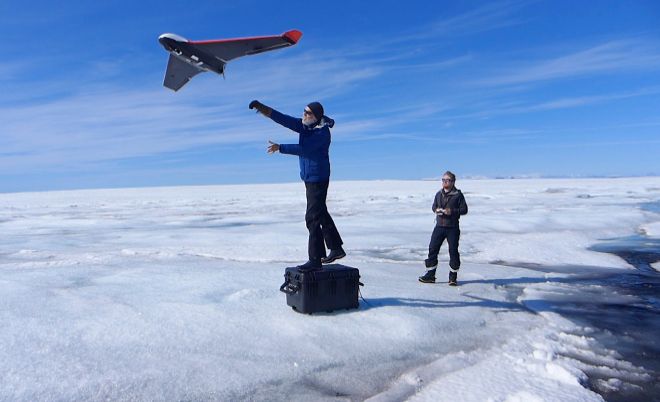- History: New Zealand newspaper warned for the first time of climate change in 1912
Each summer, as temperatures rise, thousands of lakes, rivers and streams appear in the ice sheet that covers Greenland. Many of them have an ephemeral existence: water is lost by cracks and holes that appear in the bed, known as glacial mills . These cavities - which act as natural sinks - play an important role in the structure of the great mass of ice, since they transfer the water that melts on the surface inwards . In addition, they give rise to immense waterfalls that will remain open for the rest of the summer season.
A team of researchers from the University of Cambridge (United Kingdom) has witnessed, for the first time, how one of these mills can swallow up to five million cubic meters of water in a matter of hours, reducing a lake to a third of its original volume The details are published in a new study published this week in the PNAS magazine, in which scientists analyze how this massive transfer of water has an impact on the stability of the glacier.
"We may have underestimated its effects on the Greenland ice sheet, " explains Tom Chudley, first author of the work, "and it is a key element in understanding how the polar cap responds to climate change."
Thanks to data collected on multiple drone flights in the northwest of the island, researchers have been able to observe the flow of water that passes through the mill and its subsequent trajectory once disappears inside the glacier. For this they used drones designed to withstand the extreme conditions of the Greenlandic Arctic, which have allowed them to get the first images of how the bed is fractured under these ephemeral lakes. "It's very rare to observe these fast drainage lakes, we were lucky to be in the right place at the right time, " Chudley acknowledges.
The drones flew on preprogrammed routes and, thanks to a GPS installed on board, the scientists were able to accurately geolocate and catalog the images taken during each flight. According to the authors, the water began to drain when the thaw increased the size of the lake until it reached a fracture, which had formed the previous year.
The photographs were then used to create detailed reconstructions of the surface in three dimensions . Later, thanks to drilling equipment, they explored the behavior of the water in the drainage system at the base of the glacier and created models of how the ice sheet can evolve in the coming decades as the weather continues to heat up.
Key to sea level rise
In this way their findings reveal that glaciers are subject to a higher pressure than previously estimated, caused by the melting of surface waters. In a detailed reconstruction of the event, the team showed how water created new fractures and increased existing ones. And the cracks caused by this acceleration of ice loss contribute to greater instability of the whole.
"The previous report of the Intergovernmental Panel on Climate Change (IPCC), assumed that positive and negative reactions canceled each other out," he explains, "but research like this shows that in certain regions the situation is more complex. And we need to have a more complete picture of these processes in order to properly predict the impact of climate change. "
The article also reveals that changes in the flow of ice occur in much shorter terms than has been considered possible so far. "The amount of melting water that drains inland can affect the speed at which the entire cycle is developed and that is important because, if the process accelerates, there is a risk that the contribution to the level increase will increase from the sea, "says the expert.
The disappearance of the Greenlandic ice sheet is one of the phenomena that contribute most to the global increase in water levels, an additional 18.7 cm between 1901 and 2011, 6.7 cm in the period 1993-2014.
According to the criteria of The Trust Project
Know more- Climate change
- Science and Health
- Environment
- Climate Summit
- science
Madrid climate summit Trip to Tangier, the island of deniers that is devouring the sea
Climate crisis What can you do for your planet?
ScienceThe Climate Summit, live | Felipe VI: "There is still time. We cannot, we must not fail"

